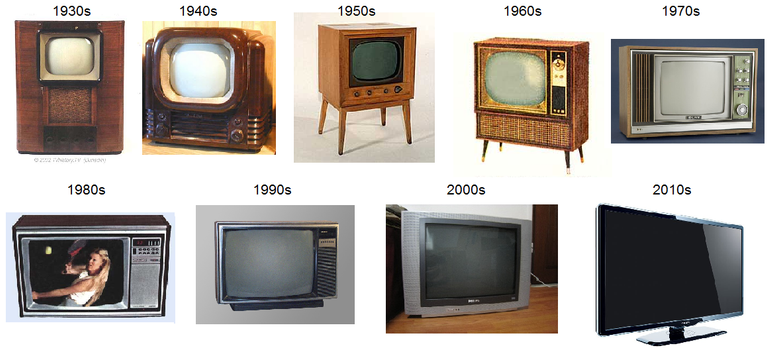Television history was not born overnight and not invented by a single inventor
by Mary Bellis.

Television was not invented by a single inventor. Rather it was through the efforts of many people working together and alone over the years that contributed to the evolution of the technology.
So let's start at the beginning. At the dawn of television history, there were two competing experimental approaches that led to the breakthroughs that made the technology possible. Early inventors attempted to either build a mechanical television system based on the technology of Paul Nipkow's rotating disks or they tried to build an electronic television system using a cathode ray tube developed independently in 1907 by English inventor A.A.
Campbell-Swinton and Russian scientist Boris Rosing.
Because electronic television systems worked better, they eventually replaced mechanical systems. Here now is a brief overview of the major names and milestones behind one of the most important inventions of the 20th century.
Paul Gottlieb Nipkow (Mechanical Television Pioneer)
German inventor Paul Nipkow developed a rotating disc technology to transmit pictures over wire in 1884 called the Nipkow disk. Nipkow is credited with discovering television's scanning principle, in which the light intensities of small portions of an image are successively analyzed and transmitted.
John Logie Baird (Mechanical)
In the 1920's, John Logie Baird patented the idea of using arrays of transparent rods to transmit images for television. Baird's 30 line images were the first demonstrations of television by reflected light rather than back-lit silhouettes.
Baird based his technology on Paul Nipkow's scanning disc idea and other later developments in electronics.
Charles Francis Jenkins (Mechanical)
Charles Jenkins invented a mechanical television system called radiovision and claimed to have transmitted the earliest moving silhouette images on June 14, 1923.
His company also opened the first television broadcasting station in the U.S., named W3XK.
Cathode Ray Tube - (Electronic Television)
The advent of electronic television is based on the development of the cathode ray tube, which is the picture tube found in modern TV sets. German scientist Karl Braun invented the cathode ray tube oscilloscope (CRT) in 1897.
Vladimir Kosma Zworykin - Electronic
Russian inventor Vladimir Zworykin invented an improved cathode-ray tube called the kinescope in 1929. At the time, the kinescope tube was sorely needed for television and Zworykin was one of the first to demonstrate a television system with all the features of modern picture tubes.
Philo T. Farnsworth - Electronic
In 1927, American inventor Philo Farnsworth became the first inventor to transmit a television image comprised of 60 horizontal lines. The image transmitted was a dollar sign. Farnsworth also developed the dissector tube, the basis of all current electronic televisions. He filed for his first television patent (patent #1,773,980) in 1927.
Louis Parker - Television Receiver
Louis Parker invented the modern changeable television receiver. The patent was issued to Louis Parker in 1948. Parker's "intercarrier sound system" is now used in all television receivers in the world.
Rabbit Ears Antennae
Marvin Middlemark invented "rabbit ears," the "V" shaped TV antennae in 1953. Among Middlemark's other inventions were a water-powered potato peeler and rejuvenating tennis ball machine.
Color Television
One of the earliest proposals for a color TV system was filed in 1880. And in 1925, Russian TV pioneer Vladimir Zworykin filed a patent disclosure for an all-electronic color television system. A successful color television system began commercial broadcasting, first authorized by the FCC on December 17, 1953, based on a system invented by RCA.
History of Cable TV
Cable television, formerly known as Community Antenna Television or CATV, was born in the mountains of Pennsylvania in the late 1940's. The first successful color television system began commercial broadcasting on December 17, 1953 and was based on a system designed by RCA.
Remote Controls
It was in June of 1956 that the TV remote controller first entered the American home. The first TV remote control, called "Lazy Bones," was developed in 1950 by Zenith Electronics Corporation (then known as Zenith Radio Corporation).
Origins of Children's Programming
While children's programming was first aired during the early days of television, Saturday morning TV shows for children started around the 50's. The American Broadcasting Company first aired Saturday morning TV shows for children on August 19, 1950.
Plasma TV
Plasma display panels use small cells containing electrically charged ionized gases to generate high-quality imagery. The very first prototype for a plasma display monitor was invented in 1964 by Donald Bitzer, Gene Slottow and Robert Willson.
Closed Captioning TV
TV closed captions are captions that are hidden in the television video signal, invisible without a special decoder. It was first demonstrated in 1972 and debuted the following year on the Public Broadcasting service.
Web TV
Television content for the World Wide Web was rolled out in 1995. The first TV series made available on the internet was the public access program Rox.